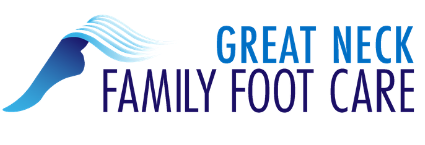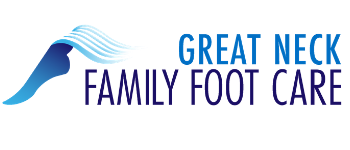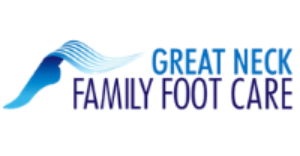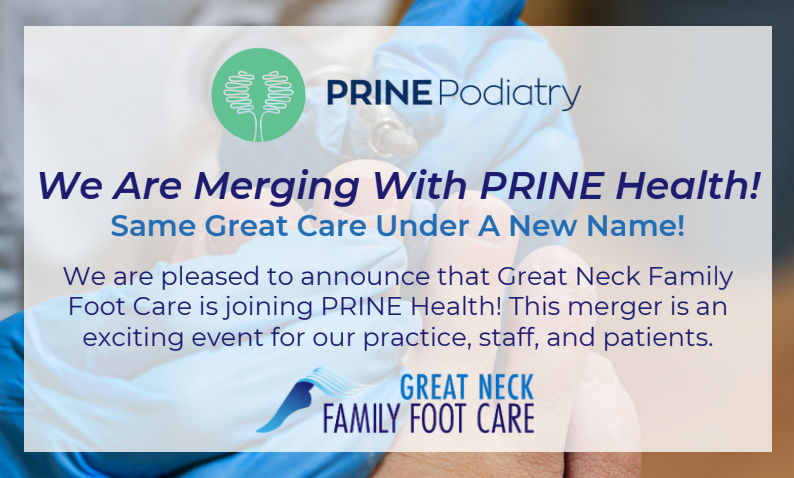
Shin Splint and Flat Foot Treatment in Great Neck
Our Podiatrist

Dr. Alec Hochstein, the “iPodiatrist™” is a 1997 graduate of the New York College of Podiatric Medicine, and is currently in Private Practice in Great Neck, NY on Long Island’s North Shore where he lives with his wife and two children.
Dr. Hochstein maintains a full time Podiatry practice, Great Neck Family Foot Care, with emphasis on Palliative Foot Care, Diabetic Foot Care, Orthotic Fabrication, Trauma, and Reconstructive Foot Surgery. In addition to his private practice, Dr. Hochstein is also the Founder/COO of OnychoLase® Laser Nail Centers as well as Pocket Professions, PC.
Dr. Hochstein is Board Certified in Foot Surgery by the American Board of Podiatric Surgery, he is a member of the American Podiatric Medical Association (APMA) as well as the New York State Podiatric Medical Association (NYSPMA).
Dr. Hochstein is privileged to be actively involved in the training of future doctors of podiatric medicine at residency training programs in New York City and Long Island New York, including the prestigious hospital programs of New York Hospital of Queens, Albert Einstein School of Medicine and North Shore –LIJ Health System.
Our staff and podiatrist at Great Neck Family Foot Care maintain a high level of experience in the diagnosis and treatment of the following foot and ankle conditions. If you are currently experiencing pain in your feet or ankles, please do not hesitate to contact our offices at (516) 482-5999 to schedule an appointment. The best path to a full recovery is early diagnosis and treatment.
Contact Us For Shin Splint and Flat foot treatment in Great Neck
Shin Splints & Flat Feet
Everyone is unique. This is something we are told many times as children and it is true on a variety of levels. While most teachers and parents mean that each person has their own thoughts and feelings, it’s also important to realize that each person also deals with their own unique configuration of inherited physical traits that often get in the way of optimal physical activity. Some people have asthma which limits the amount of heavy breathing they can do comfortably, while others have weak knees which reduce the amount of time they can run. In addition, a surprising number of people have flat feet which put them at an increased risk for shin splints. Why do people with flat feet get shin splints? Let’s find out.
WHAT ARE FLAT FEET?
For the vast majority of the population, whether a foot is pointed in the air or pressed down on the ground, there is a definitive arch. The inside edge of a healthy foot can never touch the ground at the same level as your heel and ball because it is held aloft by a taut cluster of tendons pulled tightly between the ankle and the base of your toes. Like an archery bow, because of this tendon, the foot cannot sit flat and the arch provides springy support to each step.
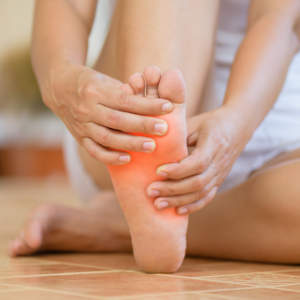
People with flat feet, on the other hand, either don’t have this tendon at all or the tendon is strung too loosely to hold the foot tight. This creates what is medically known as Pes Planus which translates roughly to “feet like plains”. You can tell if you are flat-footed simply by taking off your shoe and pressing your foot to the ground. If the place where your arch is supposed to also touch the ground and your ankle rolls inward easily, you have flat feet. This will make it harder to maintain proper posture both standing and running, causing your feet to hurt often and increasing your risk of exercise-based injuries like shin splints.
WHAT CAUSES SHIN SPLINTS?
Now that you understand flat feet, let’s talk about shin splints and see if you can figure out why the two are related before the end of the article. Shin splints are something that happens to most people as a result of running, jumping, falling, and occasionally walking. The clearest sign that you have accidentally contracted shin splints is a pain in your shins during or after active exercise on your feet.
Shin splints occur when the footsteps land too hard on the ground with a force greater than what your muscular and skeletal structures are prepared to support. Even if the muscles in your legs are quite strong, if your bones are impacted vertically by a step, you may experience pain, achiness, and swelling at a specific point in your shin. Your shins may also be tender and sore in response to gentle probes.
WHY FLAT FEET CAN RESULT IN SHIN SPLINTS
If you or someone you know has flat feet, there is a significantly increased chance of shin splints during exercise. The reason for this is that the springy arch that most people have acted as a shock-absorber, much like in your car when you go over a pothole. Every time someone with arched feet lands a step or a jump, that tendon stretches like a rubber band and absorbs some of the impacts which keep it off your shins. People with flat feet don’t have this shock-absorption so your shins are likely to take more impact damage with every step, whether you’re running, walking, or jumping down off of something.
People with flat feet are used to a little bit of foot and leg discomfort as a natural part of having an imperfect foot structure. However, the pain associated with flat feet is usually felt in the bottoms of your feet and possibly your knees and hips. If you start to feel pain, achiness, or tenderness in your shins, it’s time to see a medical professional.
Flat Foot Correction
Have you ever noticed that when you step onto a bath mat after the shower that your footprint appears as two segmented parts? Broken down into the ball and the heel, leaving a noticeable footprint. Or does it appear as the entire foot, with no gaps or spaces in the mid-section? If your entire foot touches the ground, you probably have flat feet.
Flat foot occurs when the tendons that hold the muscles into an arched position on the soles of your feet are weakened or damaged due to a few different factors. Sometimes flat feet can occur over time due to injury, aging, or other conditions such as diabetes. In other instances, the flat foot can be due to genetic or hereditary abnormalities.
Symptoms:
Symptoms of flatfoot include pain in the middle of the foot, where your foot arch should be, pain in the ankles, calves, and knees. If you have severely flat feet that cause pain or problems with walking, a Shin Splint and Flat foot treatment in Great Neck such as Great Neck Family Foot Care can help to determine the cause and offer solutions.
How Can We Correct Flat Feet?
There are several different treatments for flatfoot, however, only surgery can offer long-lasting benefits for those with flat feet. Some things a Shin Splint and Flat foot treatment in Great Neck might recommend for this condition include:
- Supportive shoes specifically for flat feet to reduce pain while walking in the shoes.
- Custom orthotics specifically for flat feet to take the pressure off the middle of the foot where arches should be located.
- Certain medications, ask your podiatrist for recommendations.
- Exercises and stretches that can strengthen certain parts of the foot.
- Corrective surgery to permanently cure flatfoot.
Surgery Options:
There are a few different surgery options for those suffering from a flat foot. Depending on your particular case, a Shin Splint and Flat foot treatment in Great Neck may suggest the following procedures:
- Tendon Transfer/Lengthening.
- Realignment of Bones.
- Joint Fusion.
- Subtalar Implant.
The most commonly recommended surgical option is the Subtalar Implant. It is minimally invasive and requires very little downtime. During this corrective procedure, a device is implanted into the sole of the foot which works as an internal orthotic within the body. This device helps to maintain the arch in the foot and can bring long-lasting effects in the way you walk.
Shin Splint and Flat foot treatment in Great Neck
If you are suffering from flat foot and are looking for a Shin Splint and Flat foot treatment in Great Neck, we can help! At Great Neck Family Foot Care, our team can treat your condition and offer to relieve you of the pain and discomfort that comes along with this issue. Visit our website to schedule your first appointment today!
Shin Splints
Have you begun to experience pain along the front of your lower leg, right around the shin bone? Has this pain started as a result of an increased running or exercise program? If you’ve answered yes to these questions, you may be dealing with shin splints. Here at Great Neck Family Foot Care, our team has helped patients overcome this issue in the past. Our expert podiatrist, Dr. Alec Hochstein, can diagnose this issue before crafting the treatment plan needed to get you back to full strength.
The Cause Of Shin Splints
Shin splints take place as a result of copious amounts of force being placed on the shinbone and the surrounding tissues. This force causes the tissues to swell, increasing the amount of stress the shinbone experiences. They can also be the result of stress reactions to bone fractures. In both cases, the most common culprit that sets off this painful chain reaction is physical activity.
Symptoms To Watch For 
Sometimes after training, your body will experience varying levels of pain. While this is normal and doesn’t require medical attention, it’s important to be able to realize when an issue such as shin splints takes place. Letting shin splints linger will not only mean you spend more time filled with pain, but it can also lead to some unfortunate medical complications. Signs that point to the development of shin splints include:
- A dull ache in the front part of your lower leg.
- Pain that increases as you exercise.
- Swelling around the shinbone.
- Tenderness and soreness in the inner part of the leg.
Treating Shin Splints
There is no one sole way to go about treating shin splints. The treatment methods our podiatrist recommends will vary on the severity of your condition. Fortunately, no matter how much pain you’re in, we’ll be able to offer assistance and try to get it under control. Examples of the ways this issue can be treated include:
- Icing and elevating your leg to reduce swelling.
- The use of custom orthotics to offer the leg more support.
- Compression wraps and bandages.
- A regimen of therapeutic stretches and massages.
- In severe cases, surgery.
Contact Us
While shin splints can be painful, when working with the right team, they don’t have to last. At Great Neck Family Foot Care, we’re committed to helping our patients any way we can. If you’d like to schedule an appointment with Dr. Hochstein to finally put an end to your shin splints, be sure to contact us today.
Dealing with shin splints
What Are Shin Splints?
Shin splint is a condition that causes copious amounts of pain and discomfort. It typically occurs in those who recently increased the intensity of their workouts or activity levels. Those who are suffering from shin splints experience tenderness, soreness, and pain along the inside of their shine bone. Swelling in the lower leg is also common. In most cases of shin splints, the symptoms will present themselves when you begin to exercise before dissipating when you stop.
Risk Factors
Understanding the risk factors that lead to shin splints is the first step in managing the condition. Being aware of these risk factors can help you work towards avoiding them. Below are some examples of what increases the likelihood of suffering from shin splints:
- Having flat feet or high arches.
- Recently starting a new running program.
- Exercising in shoes that don’t offer arch support.
- Constantly running on uneven terrain or hard surfaces.
- Increasing the intensity of your workouts before your body is prepared for this new workload.
Prevention Methods
At Great Neck Family Foot Care, our team wants to stress that the best way to deal with shin splints is to prevent them from taking place altogether. The best ways you can prevent this include:
- Don’t run at a high intensity too often.
- Replace your running shoes every 350 to 500 miles.
- Make sure your shoes offer enough arch support.
- Try cross-training so you can stay in shape without overstressing your shins.
- Perform strength training exercises to stabilize your ankles, legs, hips, and core.
Treating Your Symptoms
Even after you’ve done your part to avoid shin splints, the reality is they can still occur at any time. Fortunately, treating your symptoms is a relatively easy process. The best ways to relieve your symptoms are as followed:
- Rest your legs.
- Ice your legs for alternating periods of 20 to 30 minutes for a few hours each day until symptoms are gone.
- Take anti-inflammatories.
- Wear custom orthotics that are created by our team.
Contact Us
Living with shin splints can be a difficult task, but it doesn’t have to last. If you need treatment, contact our team today.
